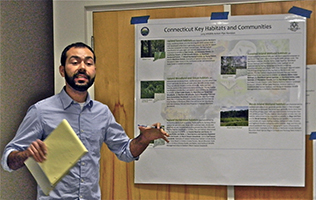

Nelson DeBarros leads session on Key Habitats. Photo: Dortha Cool Willetts.
Public Gives Wildlife Plan Feedback
MIDDLETOWN - About 30 people attended Session I of the first public feedback workshop for preparing the revised CT Wildlife Action Plan (WAP) They met at the Connecticut Forest & Park Association, Rockfall, Nov. 6 from 1:30 to 3:30 p.m. The session was also held again that evening from 6:30 to 8:30 p.m. This plan, dated 2005, was introduced in a meeting at the DeKoven House in Middletown Sept. 30. The mission of the plan is to conserve, protect and restore wildlife habitats.The state Department of Energy and Environment Protection (DEEP) is responsible for writing a revision to the plan every ten years. The revision timeline requires a rough draft of the plan in January, a working plan due to the Fish and Wildlife Service in March, and a second polished draft finished by the end of August. The completed revision is due by Sept. 30, 2015.
The workshops provide state officials with public opinions, suggestions and questions about ConnecticutÃĸâŦâĸs wildlife and environmental conservation policies. Two workshops were held in October and nine are slated in November at venues throughout the state.
Jenny Dickson, compiler of the 2005 plan, led the workshop session, assisted by her team, including Brian Hess, wildlife biologist with the Wildlife Diversity Program; Nelson DeBarros, a plant ecologist for the Wildlife Division; Kalee Resha, a DEEP wildlife biologist; and consultant Julie Victoria. Consultant Karen Terwilliger was not present at this workshop.
Dickson gave an overview of the DEEP Wildlife Action Plan, calling it, ÃĸâŦÅ"a comprehensive plan, strategic in nature, aimed not on focused actions, but broader actions, allowing flexibility in incorporating many different species, and providing for broader application of actions for conservation. Its design includes all species, a strategy new ten years ago.ÃĸâŦÂ
The plan is funded through state wildlife grants and through federal Wildlife and Conservation & Restoration Program (WCRP) funds. The plan, required by Congress, is a ÃĸâŦÅ"blueprint of conservationÃĸâŦÂ across the country--all the states and federal territories.
Dickson emphasized the plan would be widely implemented, with people referring to it and making modifications as they learn from using it.
ÃĸâŦÅ"It should also fit into existing plans and strategies,ÃĸâŦÂ said Dickson. ÃĸâŦÅ"The forest action plan, for example--this is everybodyÃĸâŦâĸs plan. ThatÃĸâŦâĸs why having folks come to these input workshops is so important. The bottom line is that we want future generations to enjoy wildlife from the accomplishments of this plan.ÃĸâŦÂ
Approval for the plan in 2005 and for its revision required inclusion of eight elements. Dickson briefly reviewed the first four elements: Species of Greatest Conservation Need, Key Habitats, Threats, and Actions.
Dickson said she wanted the groupÃĸâŦâĸs thoughts on ÃĸâŦÅ"the threats to wildlife and to their habitats and conservation actions that we need to take for wildlife in the course of the next decade.ÃĸâŦÂ
This workshop dealt only with the first four elements explained below. Dickson gave an overview of the other elements, Monitoring; Plan, Review and Revision; Outreach (draft partners and stakeholders list), and Input; Outreach and Review. This last element, including internal, public and partner input, is one in which Connecticut has excelled, due to the stateÃĸâŦâĸs pooling resources with other Northeast state to create the Regional Conservation Needs Program.
#1 - Species of Greatest Conservation Need - led by Brian Hess
Hess explained that element #1 referred to the abundance and distribution of wildlife species in Connecticut. Some new threats added to element #3 are declination of pollinators and wildlife diseases. Newly added to this element is ÃĸâŦÅ"plants,ÃĸâŦÂ which have a great impact on the habitats and food resources of wildlife. The team surveyed environmental science committees to determine what their priorities are for the plan. Additions in this category also included the amphibian mudpuppy, the big brown bat and three fish, including the sand tiger shark.
Hess asked for audience input about whether a species should be listed or not, ÃĸâŦÅ"what you see as the threats facing these species, and the actions that you think should be taken to help protect and conserve a species.ÃĸâŦÂ Following are the audienceÃĸâŦâĸs contribution:
*Snapping turtles, had not been protected by any regulations until 2012, when the Jonah Center succeeded in getting regulation to restrict hunting to a season. Broader protection is needed.
* Increased deer populations in the state causing destruction of many plant species and habitats; coyotes should be brought back in greater numbers to control the deer population.
* Beavers are not listed. Misconceptions exist about this species. The plan should include education about how beavers are in fact very important to the full cycle of the ecosystem.
#2 - Key Habitats and #3 - Threats - Nelson DeBarros
DeBarros explained the importance of habitat to wildlife and the need to conserve it was essential to a specieÃĸâŦâĸs survival and ability to thrive. He pointed out that changes to key habitat categories for the 2015 would include ten new categories: Herbaceous Inland Wetland, Tidal Wetland; Freshwater Aquatic; Estaurine Aquatic Unique, and Natural and Man-Man Habitats. Some new threats added to element 3 are declination of pollinators and wildlife diseases.
DeBarros asked participants to consider habitat Loss and development. Some of the suggestions or remarks made by participants were as follows:
* Protect grasslands and riverside habitats and check deterioration of mountainside cliffs.
* Pesticide use near city ponds, on public grounds such as schools, and private property such as lawns and golf courses threatens many water species.
* Are city and towns are aware of the plan and using it; for example in the Middletown redevelopment riverside project?
*Pollution of wetlands and ponds or streams near businesses such as supermarkets, under bridges, and near housing developments should be investigated.
* Cats, owned or feral, kill birds. More advertising is needed on neutering cats to reduce numbers of abandoned cats.
* More research and protection of Cromwell Meadows Wildlife Management Area which has many ÃĸâŦÅ"NoahÃĸâŦâĸs ArkÃĸâŦÂ (floating meadows) species; similar areas are near Pratt and Whitney near outlet to Hubbard Brook, and Wangunk Meadows WMA (a home of the New England Cottontail). Dickson said the New England cottontail is a ÃĸâŦÅ"Most Important Species.ÃĸâŦÂ Connecticut has the largest percentage of this species in the world. What Connecticut does for that species will probably determine whether that species survives or goes extinct.
* More funds and guidance are needed to manage recently purchased lands by land trusts, cities, foundations, etc.
* Climate change plans are needed to protect tidal wetlands and estuarine aquatic areas.
#4 Conservation Actions - Julie Victoria and Jenny Dickson
Julie Victoria said, ÃĸâŦÅ"We need your ideas on how we can preserve the key habitats and protect the species of greatest need. What are the things we can do that we have not captured on our charts so far?ÃĸâŦÂ ParticipantsÃĸâŦâĸ suggestions were as follows:
* Include important data information gathered by the land acquisition group.
* Enhance studies of snapping turtle demographic studies to better protect the species.
* Study the effect of chemicals in runoff from private lawns and public lands on pond species.
* Regional cooperation could involve municipalities for funding. One townÃĸâŦâĸs projects could be duplicated in other states.
* The environmental Literacy Plan, started five years ago by Susan Quincy is up for renewal; the project, ÃĸâŦÅ"No Child Left InsideÃĸâŦÂ would be valuable to the Wildlife Action Plan by helping to create future wildlife and natural resource stewards in the next generation.
* The Jonah CenterÃĸâŦâĸs biodiversity data base with maps, and photos and forms for registering the sighting of a particular species, lacked funding to continue it in Middletown, but, used at the state level, it might be a great way of engaging the public through observing nature and reporting it, thus provide useful data for the plan.
* Address ÃĸâŦÅ"Nature Deficit DisorderÃĸâŦÂ by encouraging folks to get outdoors to enjoy nature and watch wildlife.
*Post more lists of species native to state hiking spots and in municipality hiking areas with a hotline phone number for visitors to call if they see a species they havenÃĸâŦâĸt seen before.
*More interpretative signs along hiking trails at state parks. People read them, but the signs could be more educational about what is there, like a ÃĸâŦÅ"riparian bufferÃĸâŦÂ or ÃĸâŦÅ"erosionÃĸâŦÂ or ÃĸâŦÅ"habitat ofÃĸâŦÂĻ.ÃĸâŦÂ, etc. Providing leaflets add more information, an inexpensive project. The signs could be in Braille, as has been done at Harkness Park and West Hartford Reservoir trails.
* Urge state legislation that affects city and state lands use of pesticides be broadened to cover private property owners. Educate the public about the dangers to wildlife of the chemicals they are using on their lawns.
* Use the kind of biological diversity survey carried out by school children in Middletown two years ago. This could be done as a statewide basis by kids without remuneration. The Environmental Literacy Plan that was started five years ago by Susan Quincy, and is up for renewal now, could be incorporated into the plan.
* Wesleyan and Middlesex press need to be encouraged to come the workshops; this might attract students who are looking for ways to develop required reports or projects. Get a slot on WESU radio to feature the plan and broaden public information.
* Develop synergy between all ÃĸâŦÅ"conservationÃĸâŦÅ" plans; Cross reference with Green Plan, Wildlife Action Plan, Forest Action Plan, and Environmental Literacy Plan.
*Encourage more culturally and ethnically diverse participation in conservation and volunteer projects; broaden our audiences in new ways, churches, 4H, YMCA, and youth groups.
Victoria congratulated the participants, saying, ÃĸâŦÅ"You have given us a lot of excellent ideas, which we will take back and compile, but we are still working hard on what actions we should take - which ideas will get the most bang out of the bucks. It doesnÃĸâŦâĸt stop here. What you have done today is to help us see what is important to you.ÃĸâŦÂ
Dickson also thanked the participants, remarking, ÃĸâŦÅ"It has been interesting to me after working on the plan 10 years ago, is to find out that people did use it. That people found it useful is the biggest checkmark for me. A lot of our conservation partners have mentioned over the years, we able to use the plan to get this or this grant.ÃĸâŦÂ
Victoria added, ÃĸâŦÅ"We are hearing so many success stories from people who have used the plan. So, we ask you also, if you know of some good examples of success, email us. We want to report not just what DEEP did, but what the localities and partnering organizations are doing, too.ÃĸâŦÂ








